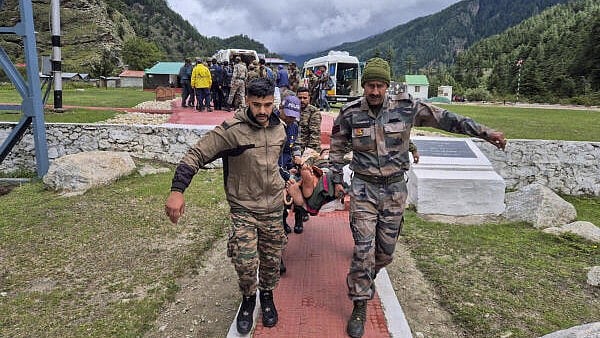
Rescue operation underway following flash floods triggered by a cloudburst at Dharali region, in Uttarkashi district of Uttarakhand.
Credit: PTI Photo
An angry nature has again unleashed itself on Uttarakhand, taking lives and destroying property. A massive cloudburst and flash floods that wreaked havoc at Dharali in Uttarkashi on Tuesday have killed at least five people and marooned many others. Much of the village has been buried under mud and slush, and landslides have blocked the roads, impeding the rescue missions. Huge waves could be seen roaring down the slopes, reviving memories of the 2013 floods in the Kedarnath region, which destroyed many villages and killed about 5,000 people. Several Indian Army personnel are feared trapped. Some parts of the district had experienced heavy and incessant rain in the early part of the week, but the cloudburst caused the sudden deluge. There are warnings of more rain in the coming days.
It was only a year ago that a severe landslide in Kerala’s Wayanad district led to the loss of hundreds of lives and caused much damage. There have been other extreme climate events and manifestations of resistance from nature to the assaults made on it in different parts of the country. Last week, the Supreme Court warned that if the ecological balance in Himachal Pradesh continued to deteriorate, the state could vanish. That might sound like exaggeration, but the warning could come true in the long run. Entire villages disappeared in the Kedarnath floods and the Wayanad landslide. A glacial lake outburst laid to ruin the Chamoli region in 2021, and many places in the Joshimath town and the nearby areas subsided with houses and other buildings in 2023. Dharali might not survive the flooding as a village. All this can happen on a much bigger scale.
Extreme climate events are increasing in number and intensity amid extensive deforestation and construction activities. Global warming has made weather patterns unpredictable and intensified heat and rainfall. Developmental activities, including the construction of dams, roads, and buildings, and deforestation, have put pressure on the ecology of the region. The Himalayas are the world’s youngest mountain ranges and are still forming. They remain fragile and vulnerable to external shocks and pressure. The governments have continued to promote religious and other forms of tourism and allowed unrestricted traffic in the Himalayan states for political and economic reasons, without giving heed to counsel from the courts, experts, and the people. Dharali is on the religious tourism route and is known for its scenic beauty. Now, it lies under rubble, and the lesson should not be lost.
